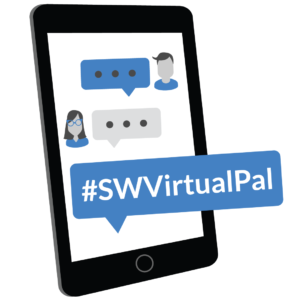Using LinkedIn for #SWVirtualPal
Editor’s note: This post is cross-published on the Social Work Virtual Pal website. Social Work Virtual Pal is a global and virtual community of practice for the social work profession, that digitizes the practice of having a pen pal for professional learning and networking. This community focuses on connection and collaboration among social workers to offer the profession with an opportunity to harness its collective knowledge for the greater good. We have resources for social work educators so, please consider incorporating #SWVirtualPal in your social work course. Learn about Social Work Virtual Pal here.
Social Work Virtual Pal now has a LinkedIn Group for social work students, instructors, and practitioners to connect with other social workers around the world. Similar to our Twitter account, this is a virtual space that digitizes the practice of having a pen pal for professional learning and networking. In addition, this community focuses on connection and collaboration among social workers to offer the profession an opportunity to harness its collective knowledge for the greater good. In this blog post, we offer details for creating a LinkedIn Profile, establishing your digital networking goals, and then joining our LinkedIn Group to find your #SWVirtualPal.
Where to start
LinkedIn is a social networking site designed specifically for professional use and offers a robust user profile system that serves as a digital resume. It is a great place to establish your online presence as a social work student or practitioner. As with any social media platform, you’ll want to start with creating your LinkedIn profile. There are many online tutorials on creating a high-quality LinkedIn profile, and LinkedIn’s Help feature offers many tips and guides on navigating the platform. Before getting started with your profile, you will want to have a professional-looking photo and a copy of your resume handy. Set aside a few hours to create your profile. Here is a good profile checklist designed for college students, but applicable to anyone.
Because #SWVirtualPal is designed to help social workers from around the world connect with other social workers, there are some additional features to consider adding to your profile:
How to define your Teaching Values
Editor’s Note: This blog post is one of a three-part series about how to write a values-based teaching philosophy. In this blog post, we (April Love and Laurel Hitchcock) offer a process for identifying your teaching values. The second post covers tips for writing and presenting a values-based teaching philosophy, and in the third post, we share our own values-based teaching philosophies that resulted from this process. This post is cross-published on April’s Blog – Genuine Curiosity: Navigating Nursing Education Now.
Having an articulated teaching philosophy is an expectation in higher education, but writing a teaching philosophy is hard work. It requires an educator to define their professional identity in a way that explains why and how they teach. Additionally, today’s educators are constantly asked to weigh in on various issues, such as when, how, and how often to use innovation for instruction, how much time should be focused on content versus reserved for flexible discussion, and whether to use a traditional or flipped classroom model, where there’s no clear right or wrong answer. And, because the topics can be as diverse as the courses and students we teach, it’s important to have a values-based framework that can support your decision-making process. Having a clear understanding of your personal values and, perhaps more importantly in this instance, your teaching values can help you navigate challenging or crucial conversations by giving you the language to express your views and understand their origin.
The process of getting to one’s teaching philosophy is reflective, requiring time and deep thinking about one’s beliefs related to teaching and learning. Identifying one’s teaching values offers an educator clarity about what is important and meaningful, and makes it easier to set and prioritize goals as well as make decisions by aligning these tasks with one’s values. Not only is the process highly personalized, so is the end product. While there is no one right way to explore one’s teaching values, we have adapted a common approach for identifying values to focus on the practices of teaching and learning.
Developing a Personalized Social Media Policy for Social Work Practice
Editor’s Note: This blog post is adapted from the Second Edition of the Social Media Toolkit for Social Work Field Educators.
There are many reasons for social workers to have a personalized social media policy – to maintain boundaries, protect privacy and confidentiality, and model professional behavior. To be clear, I am not referring to the policy that your organization or institution might have, directing the faculty, staff, and students on when it is okay to use social media, but one that you develop and follow as an individual practitioner, student, and/or educator. The purpose of a social media policy is to inform clients, students, colleagues, and others about when, how, and why you use social media in a professional capacity. From an ethical lens, this is a recommended practice per National Association of Social Worker’s (NASW) Technology in Social Work Practice Standard 2.10 – Social Media Policy and fits with the NASW Code of Ethics standards of informed consent with clients (1.3e-i), respect with colleagues (2.1), and when conducting supervision and consultation (3.1).
The following steps provide a guide for developing a social media policy that can be used as an assignment in a classroom with students or adapted for practitioners:
A review of Teaching & Learning in Social Work for 2020
2020 was a strange year with many firsts for me – first global pandemic, first sabbatical, first live sessions in an online course, etc. Because of all these firsts, blogging took a bit of back seat to some of my other projects and goals for the year. I had four goals for the blog over the year, and some minor successes. They were:
#1 – Publish 30 posts – only published 19
#2 – Enhance the reach of the blog – there were almost 45,500 visitors from 153 different countries with each visitor spending an average of 1 minute on the blog.
#3 – Build a culture of engagement – only had 10 comments for the year.
#4 – Publish content in other places – there will be two articles in 2021 with content from the blog.
Outside of these goals, I did update content on the blog and created an archive page. The two most popular blog posts of 2020 were:
A Love Letter to Social Workers on the Front Lines of COVID-19 (4/10/20) by Melanie Sage with over 24,000 visits
The Power of Lighting in a Virtual Classroom: Tips on Improving Webcam Lighting for Online Educators (3/16/20) by Agata Dera with over 3,000 visits
Pinterest Assignment for the Social Work Classroom

A few years back, my colleague, Dr. Lisa Baker at Samford University’s Department of Social Work, and I collaborated on a study about a technology-meditated assignment that we developed for a Human Behavior and the Social Environment (HBSE) course. Our goal was to breathe some new life into a stale assignment. In this post, I want to share how we approached the development, assessment, and dissemination of our study related to this tech-mediated assignment.





